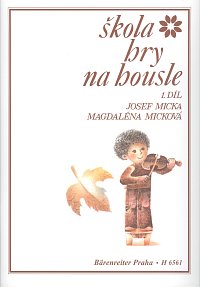Thirty Melodies with Rhymes for the Youngest Violinists
 Bestsellery
Bestsellery
 Właśnie zakupione
Właśnie zakupione
| Wydawnictwo: | Barenreiter |
| styl muzyczny: |
muzyka dla dzieci, uczniów i studentów
muzyka dla szkół muzycznych szkoły i książki instruktażowe |
| aranżacja : | melodia |
| obsada: | solo |
| Stopie: | początkujący |
| tekst utworów: |
angielski
czeski niemiecki |
| format: | książka |
| seria: | Noty do školy |
Dane
| Kod produktu: | H8060 |
| autor: | Micková, Magdaléna |
| ilość utworów: | 30 |
| ilość stron: | 36 |
| język : |
czeski
niemiecki angielski |
| ISMN: | 9790260109766 |
| waga: | 176 g |
Spis utworów (30)
- Vrána
- Houby
- Kohoutek
- Čerti
- Kalamajka
- Pepík
- Mašinka
- Honička
- Větříček
- Pekař
- Veselá písnička
- Písnička
- Sedlák
- Had
- Bába
- Pešek
- Koleda
- Sníh
- Pivo
- Mikuláš
- Moře
- Kočka
- Na horách
- Karlík
- Měla Babka
- Žežulička
- Drak
- Liška
- Listopad
- Ententýky
Opis produktu
"Thirty Melodies with Rhymes" is a new violin method for children about 5 years old who are beginning to play the violin. The publication was written by the well-known Czech violin teacher Magdalena Mickova, who has put her years of experience in teaching the youngest violinists to good use.
In cooperation with the teacher, the child first learns how to hold the violin correctly, put fingers on the fingerboard, strum and pull the bow. Only then can the little violinist move on to playing the first pieces on this album.
As the title suggests, the contents of the publication are simple melodies in several bars, written in unusually large notes for children, which, however, do not serve primarily to teach reading music notation, but rather to give an approximate orientation. The melodies are aimed at practising major fingering in first position. The author considers it quite crucial to include the text in the teaching of the youngest violinists. Therefore, each piece is accompanied by a rhyme that will make it easier for children to master the rhythm, and in addition, they will enjoy playing. The pieces are arranged roughly according to difficulty, with the most difficult, requiring legato playing, at the end.
The publication also includes a link to a site where you can watch instructional videos.










